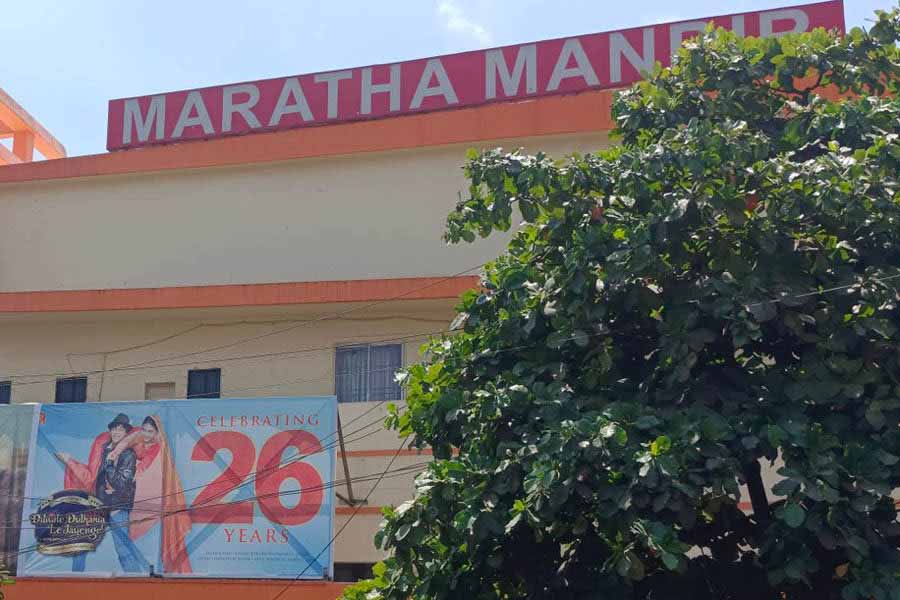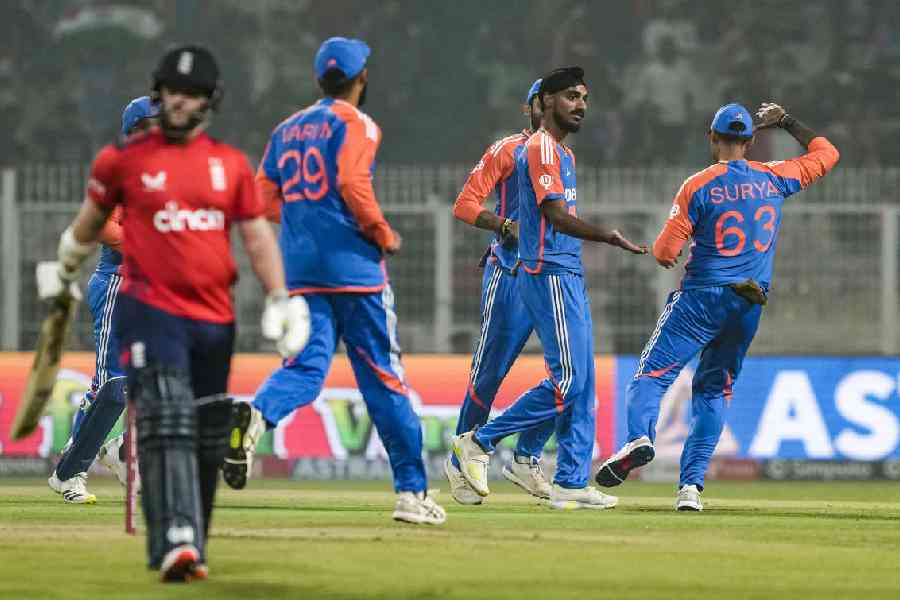Even as a 10-year-old, I knew there was something wrong. I knew that Hindi film heroes and heroines danced. But there was something not quite right in the way Vinod Khanna and Amitabh Bachchan were going about it. For one, there was no song accompanying the sequence. It was in fact a rather dramatic scene they were putting across. I hadn’t heard of Luis Bunuel, and so wasn’t sure whether a perfectly normal commercial film had suddenly taken a turn for the surreal (not that I was aware of the terms ‘commercial cinema’ and ‘surreal’, either, at the time).
I did not know of ‘break dance’ (in fact, Michael Jackson would perform it for the first time only five years later, in 1983). Neither had I seen a ‘Nagin’ film yet that could provide context to the way the two stars were swaying on screen. It is only after three minutes of this ‘dance’ that it dawned on me that Vinod Khanna and Amitabh Bachchan were shifting shape to the rivulets of water running down the screen. It was raining outside.
Right through the 1980s and ’90s, I spent considerable time at some rather rundown and ramshackle theatres, but this one in Bokajan, Assam, 1978, is right up there. I have forgotten its name. The film was Hera Pheri. And this was its last show, with Shammi Kapoor’s Rajkumar being the next change (we were given complimentary tickets for this).
I watched Hera Pheri again in Uphaar, Delhi, in 1985 (a theatre in decidedly better shape than the one in Bokajan, though that was to change a decade down the line). These memories came rushing back as I watched Hera Pheri and Kaalia recently. This time at PVR theatres, which boast seats priced at Rs 500.
Small towns, cinema halls and family outings
The hall in Bokajan does not exist anymore. Nor does Uphaar, following the fire on June 13, 1997. Almost all the single-screens that ignited and nurtured my love for cinema in the 1980s have either ceased to be or made way for malls and multiplexes. Many in the wake of the tragedy in Uphaar. As noted journalist Sidharth Bhatia wrote following the news of Eros, Mumbai, closing, ‘When an old cinema shuts down, a million memories die with it.’
As I read the essay, my mind went back to that day in Bokajan. The four of us – my parents, my eight-year-old brother and me – making our way to the hall. It was about half-an-hour walk from our house, including the mandatory stopover for Gold Spot and bhutta at a petrol pump. We watched a number of films at the theatre – Shashi Kapoor’s Sangram, V. Shantaram’s Geet Gaya Pathharon Ne, Dev Anand’s Bullet, the Assamese classic Chameli Memsaheb – and yet that walk, the four of us, our parents holding our hands, and that Gold Spot and bhutta interlude, are as intrinsic a part of my memory as that theatre.
Dimapur, Nagaland, a half-hour drive from Bokajan. Its theatres Eros, Latika and Friends, the films we watched there (Trishul, Ahutee), the outings at the restaurants Plaza and Breeze following a film show, Dad buying us our first gramophone record (a portable box one), the day we watched Adha Din Adhi Raat.
Sholay at Eros (how did they allow my brother and me to the film given we were barely ten years old?) with Mother frantically trying to cover our eyes as Gabbar chops off Thakur’s hands. We returned home that evening to find that she had lost the key to the house (Dad was on tour). We had to call in help to break open the door. I watched Sholay again years later, in 1988, in Paras, New Delhi, another theatre that is no more. And even in 1988, Sholay played to a full house, I had to buy tickets in black and could scarcely make out the dialogues with the audience chanting each dialogue before the actors could.
A little older, and in Shillong; the theatres Kevin, Anjali, Dreamland, Biju. Running away from school with classmates one day to watch Sun Sajna. A full house (as all Mithun Chakraborty films ran to in Shillong – it was legend that the Barjatyas had gifted the owner of Kevin a van on Tarana completing a year at the theatre). There were no tickets available for Sun Sajna, but my resourceful classmates arranged for modas, and we watched the film sitting on them in the aisle.
Almost 34 years later, I went back to Shillong. None of the theatres existed anymore. I looked in vain for that afternoon when the four of us walked across Police Bazar after booking tickets for Amitabh Bachchan’s Mahaan, and ended up buying our first TV set, a Crown portable black-and-white model. Or that sheepish look on the faces of four of our school teachers whom we came across in Anjali theatre. As my brother and I wished them ‘good afternoon, ma’am’, they seemed rather embarrassed at being ‘caught’ watching Namak Halaal by their wards.
The theatres offered an escape
By far the most enduring memories pertain to the theatres in Delhi. Particularly in the years 1984 to 1990. These were the years that shaped India and the world. Diego Maradona avenged the United Kingdom over the Falklands in 1986. Ronald Reagan spoke of Star Wars. Mikhail Gorbachev ushered in glasnost and perestroika. The Chinese army massacred protesting students at the Tiananmen Square. In one of the abiding images of modern Russian history, Boris Yeltsin stood on a tank outside the parliament. In India we had the assassination of Indira Gandhi, the anti-Mandal Commission agitations, L.K. Advani’s rath yatra. My world, however, revolved around Jeetendra and Sridevi gyrating, and Dharmendra and Shatrughan Sinha scowling in the confines of smelly film theatres.
Part of the fondness for these theatres might be because the teens often constitute the best years of our lives. Part of it might be because saddled with an academic stream I had no interest in – I had more or less been pushed into studying commerce and finance – the theatres offered an escape from balance sheets and profit and loss accounts.
Part of it might also have something to do with the fact that there were at least five theatres within walking distance of my home and college – Archana (which is now home to NDTV), Savitri (now a nondescript DT theatre tucked away in the middle of a marketing complex), Paras (now home to, among other things, a Haldiram outlet, a Dominos and a Pizza Hut), Sapna and Chandralok.
Nothing else can explain watching 169 films in the three years it took me to graduate. That’s 56 films per year, a film a week on average. At a time when both cinema halls and Hindi cinema were nothing to write home about. This was the era of Jeetendra-Sridevi-Jaya Prada going ta-thaiya-ta-thaiya with matkas on beaches. I watched these.
This was the era of multi-starrers which had the same bunch of actors – Dharmendra-Shatrughan Sinha-Sunil Dutt-Mithun Chakraborty-Raaj Kumar – in various permutations and combinations so that I would often have problems recalling which film had what stars. Was it Watan Ke Rakhwale that had x, y and z, or was it Insaniyat Ke Dushman? Or both? Some of these films were so bad, I would often walk out to the foyer in the middle of the show to glance through the ‘coming soon’ boards with film stills. I remember these theatres more often for these posters and stills than for the films I watched. But even the worst of these, in the most dilapidated of halls, offered something more interesting than what college had to offer.
The theatres were worse, if that was possible. Given the rise of the videocassette player and video piracy, theatres were in a bad way. Filmgoers used to today’s swanky seats and perfumed spaces will find it impossible to believe that theatres could have rats scurrying around. Or seats with stuffing coming apart, likely to topple over if you so much as moved in excitement at what was unfolding.
A musty smell pervaded the theatres. Paan stains littered the foyer. Particularly, if it was a night show (9.30pm) at a theatre like Paras which was patronised by daily-wage workers. Watching Mujrim (Mithun Chakraborty) with them, many in their lungis and sleeveless vests, the air reeking of bidi and sweat, soil and unwashed feet, the weariness of a long hard day toiling under the sun giving way to the whistles and cheers that accompanied ‘Raat ke barah baaje’ and ‘Boom boom laka laka’. There was something primeval about it. This is how a film was meant to be watched.
(This is the first part of a two-part article.)
Shantanu Ray Chaudhuri is a film and music buff, editor, publisher, film critic and writer











